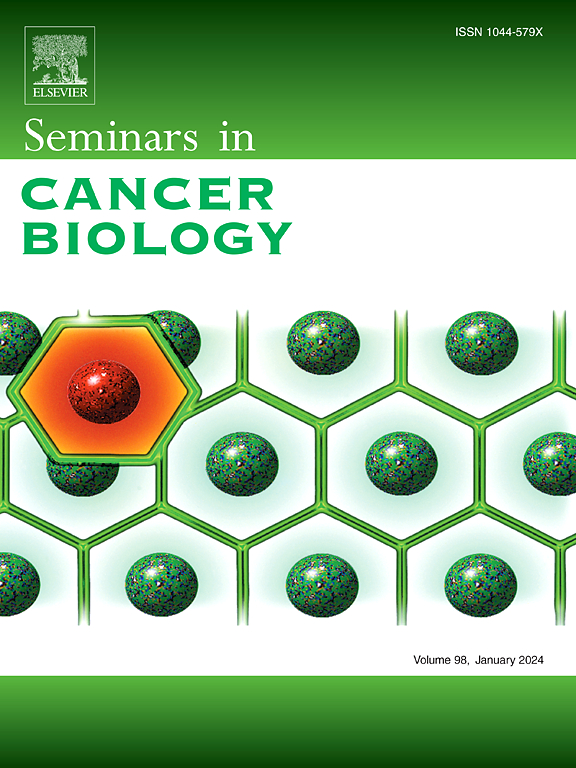The converging roles of microRNAs and lipid metabolism in atherosclerotic cardiovascular disease and cancer
IF 15.7
1区 医学
Q1 ONCOLOGY
引用次数: 0
Abstract
Cancer and atherosclerotic cardiovascular disease (ASCVD) are the main causes of mortality worldwide. The complex relationship between these two diseases has long puzzled scientists, with lipid metabolism emerging as a promising area for research and therapy of both diseases. Cholesterol accumulation promotes the formation of atherosclerotic plaques, while dysregulated lipid metabolism favours the progression of tumours. MicroRNAs (miRNAs) have been identified as key post-transcriptional regulators of lipid metabolism, influencing cholesterol synthesis and efflux, fatty acid oxidation and lipoprotein function. MiR-33, miR-144 and miR-122 modulate important target proteins such as sterol regulatory element-binding proteins (SREBPs), ATP-binding cassette transporter A1 (ABCA1) and peroxisome proliferator-activated receptor gamma (PPARγ) and thus control metabolic reprogramming in both cancer and ASCVD. In cancer, miRNA-mediated lipid reprogramming promotes proliferation, immune evasion and metastasis, whereas dysregulated miRNAs in ASCVD contribute to foam cell formation, chronic inflammation and vascular dysfunction. The dual role of miRNAs, acting either as tumour suppressors or oncogenes, highlights their complex impact on lipid-related pathophysiology. Moreover, miRNA-based therapeutic strategies, including antagomirs and miRNA mimics, hold promise for targeted intervention in both diseases, which could reduce ASCVD risk in cancer patients and improve long-term outcomes. Understanding the intricate interactions between miRNAs, lipid metabolism and disease progression provides new insights into the overlapping molecular mechanisms of cancer and ASCVD and opens new therapeutic opportunities in the field of cardio-oncology.
microrna和脂质代谢在动脉粥样硬化性心血管疾病和癌症中的聚合作用。
癌症和动脉粥样硬化性心血管疾病(ASCVD)是世界范围内死亡的主要原因。长期以来,这两种疾病之间的复杂关系一直困扰着科学家,脂质代谢成为这两种疾病研究和治疗的一个有前景的领域。胆固醇积累促进动脉粥样硬化斑块的形成,而脂质代谢失调有利于肿瘤的进展。MicroRNAs (miRNAs)已被确定为脂质代谢的关键转录后调节因子,影响胆固醇的合成和外排、脂肪酸氧化和脂蛋白功能。MiR-33、miR-144和miR-122调节重要的靶蛋白,如甾醇调节元件结合蛋白(SREBPs)、atp结合盒转运蛋白A1 (ABCA1)和过氧化物酶体增殖激活受体γ (PPARγ),从而控制癌症和ASCVD的代谢重编程。在癌症中,mirna介导的脂质重编程促进增殖、免疫逃避和转移,而ASCVD中mirna失调有助于泡沫细胞形成、慢性炎症和血管功能障碍。mirna的双重作用,既可以作为肿瘤抑制因子,也可以作为致癌基因,突出了它们对脂质相关病理生理的复杂影响。此外,基于miRNA的治疗策略,包括安塔戈米和miRNA模拟物,有望对这两种疾病进行靶向干预,从而降低癌症患者的ASCVD风险并改善长期预后。了解mirna、脂质代谢和疾病进展之间复杂的相互作用,为癌症和ASCVD的重叠分子机制提供了新的见解,并为心脏肿瘤学领域开辟了新的治疗机会。
本文章由计算机程序翻译,如有差异,请以英文原文为准。
求助全文
约1分钟内获得全文
求助全文
来源期刊

Seminars in cancer biology
医学-肿瘤学
CiteScore
26.80
自引率
4.10%
发文量
347
审稿时长
15.1 weeks
期刊介绍:
Seminars in Cancer Biology (YSCBI) is a specialized review journal that focuses on the field of molecular oncology. Its primary objective is to keep scientists up-to-date with the latest developments in this field.
The journal adopts a thematic approach, dedicating each issue to an important topic of interest to cancer biologists. These topics cover a range of research areas, including the underlying genetic and molecular causes of cellular transformation and cancer, as well as the molecular basis of potential therapies.
To ensure the highest quality and expertise, every issue is supervised by a guest editor or editors who are internationally recognized experts in the respective field. Each issue features approximately eight to twelve authoritative invited reviews that cover various aspects of the chosen subject area.
The ultimate goal of each issue of YSCBI is to offer a cohesive, easily comprehensible, and engaging overview of the selected topic. The journal strives to provide scientists with a coordinated and lively examination of the latest developments in the field of molecular oncology.
 求助内容:
求助内容: 应助结果提醒方式:
应助结果提醒方式:


